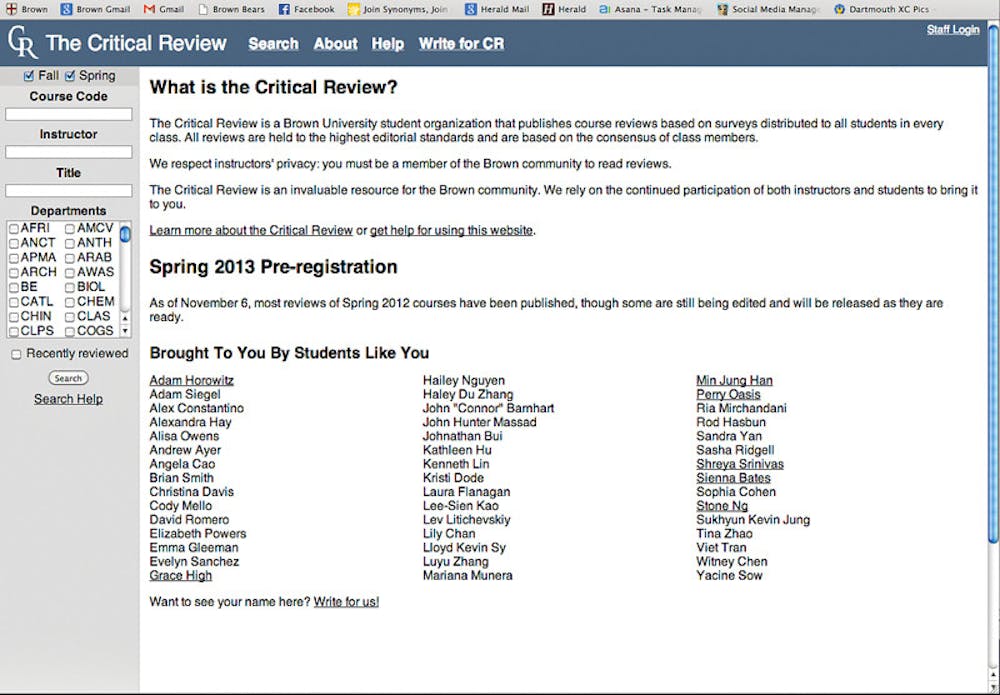A lack of updates to the Critical Review’s course reviews in recent years has caused the site to experience challenges in retaining prominence as a student resource during shopping period.
The Critical Review announced updates for courses conducted in the fall 2012 semester in April on the group’s Facebook page but was unable to meet group leaders’ expectations for writing new reviews for courses offered last semester. Adam Siegel ’14, Critical Review editor-in-chief, said the lack of updates was due to a technical issue with the printers, which meant survey packets were not delivered to faculty members in time.
“We really screwed up,” Siegel said, adding, “It was definitely our fault, and we won’t do it again.”
Many classes have reviews that were last updated in 2009 or 2010, with information on faculty members who no longer teach the course. Some students said without more current data, it is difficult to rely upon the Critical Review when selecting courses.
Critical Review leaders said they have suffered from a lack of manpower to continue updating course reviews.
“We recruit just enough people to survive and stay afloat,” said Rod Hasbun ’15, a Critical Review editor.
The Critical Review has an executive staff team of seven, which includes one technical staffer who maintains the entire Critical Review website, and around 20 to 25 writers and editors, Siegel said.
About 1,900 courses are currently offered at the University by over 730 faculty members, said Curricular Resource Center Director Peggy Chang ’91. She added that as the number of courses has consistently risen, and as two-thirds of faculty members have arrived in the past 10 years, keeping up has become more difficult for the site.
Chang said when she was an undergraduate in the late 1980s and early 1990s, “the Critical Review ... was supremely central” in students’ decision-making process for courses. But like any older organization, the Critical Review needs to rethink its approach, she said.
“The Critical Review student (staff) may not fully realize the exponential growth that’s taken place” in academic choices at the University, Chang said. “So when there’s that much choice, it’s wonderful, but I think we all need to acknowledge it’s a little overwhelming.”
The Critical Review should think more strategically about the number of classes the group targets and should consider shifting the survey completion process online to maximize student responses, Chang said. But she added that she believed the group still has promise as a resource.
“I don’t think the Critical Review’s time is over yet,” she said.
The Critical Review has also faced budgetary challenges.
“It’s actually a very small organization. People think that since everyone visits it, it has to be a large and extremely well-funded organization, and it really isn’t,” Hasbun said.
“A year or two ago (the Undergraduate Finance Board) wanted to just cut the entire budget for the site, which is ridiculous,” said Cody Mello ’15, Critical Review software and operations engineer. Mello said UFB ultimately did not cut the group’s website funds, but he added that chances of any funding increase are slim.
Critical Review leaders said they have had problems with data collection. Each year, the Critical Review distributes packets to between 900 and 1,000 undergraduate courses, Mello said.
“A majority of professors don’t respond” to Critical Review staffers’ requests for surveys to be collected, Siegel said. The survey packets are handed out to department secretaries and stuffed in professors’ mailboxes, but only about 35 percent of these packets are returned to the Critical Review staff for evaluation, he said.
This low response rate is linked to the fact that many University departments already issue their own course surveys to students, Hasbun said. Because of these other surveys, many faculty members “think the Critical Review is superfluous,” he said.
Critical Review staffers said they have been considering implementing some changes. One goal is greater communication with students and faculty members to increase the number of survey responses, Siegel said.
“We are trying to revamp the Critical Review and rejuvenate it to a certain extent,” he said.
The group is contemplating moving the survey completion process online, Critical Review staffers said. The surveys are currently two pages and require students to choose a number on a numerical scale and to complete five or six short answer questions, Mello said, adding that digitizing them could pose new problems.
An online process might make it easier for students to avoid taking the survey, Mello said. “They might forget or just don’t care.”
But Mello said he believes the Critical Review is a useful resource still widely used.
“I walk around campus, and I’m in the CIT, and I see people on computers using the Critical Review,” he said.
Ria Mirchandani ’15, a Herald opinions columnist who said she shopped 46 courses this semester, said she finds the Critical Review to be a helpful resource in narrowing down courses. But she said the site should not determine students’ final choices.
“I was shocked that my Meiklejohn, my faculty advisor, my international mentor — none of them told me about (the Critical Review),” she said.
As an independent studies coordinator at the Curricular Resource Center and a Meiklejohn, Mirchandani said she believes the site is still valuable to first-years.
“It’s one of the first things I tell my Meiklings,” she said.

ADVERTISEMENT




